Abstract
OBJECTIVE--To test the dependency of haemolytic and cytocidal manifestations of pathogenicity of Trichomonas vaginalis on direct contact between the target cells and the organism. TEST ORGANISM--T vaginalis strain Baltimore 42. DESIGN--Haemolysis in the presence of live T vaginalis and of its filter-sterilised metabolic products was compared. The dependence of haemolytic and cytocidal effects on retention of low pH of metabolic products of the organism was demonstrated by parallel titrations of sterile filtrates in normal saline and in phosphate buffered saline (PBS) pH 7.0. RESULTS--Near complete lysis was obtained when erythrocytes mixed with T vaginalis were incubated for 1 h at 37 degrees C in saline containing 1% glucose. The same degree of haemolysis was present in filter-sterilised glucose-saline in which the organism was incubated (1 h/37 degrees C) before erythrocytes were added and incubated under the same conditions as in the mixture with the organism. The degree of haemolysis in filtrates was dependent on retention of low pH (below 5.0) of the suspending fluid in which the organism alone was incubated. Dilution of filtrates in PBS, as opposed to normal saline, abolished or diminished the haemolytic effect. Presence of glucose (energy source) in the saline during incubation of the organism had a pronounced enhancing effect. The production of haemolytic metabolites was temperature dependent, whereas the haemolytic process per se was not. The effect was not an exclusive property of T vaginalis since it was also demonstrated with other trichomonads. The same filtrates applied to tissue culture exerted cytocidal effect strikingly similar to that observed in the haemolysis experiments. CONCLUSION--Neither haemolytic nor cytocidal effect of T vaginalis was contact-dependent.
Full text
PDF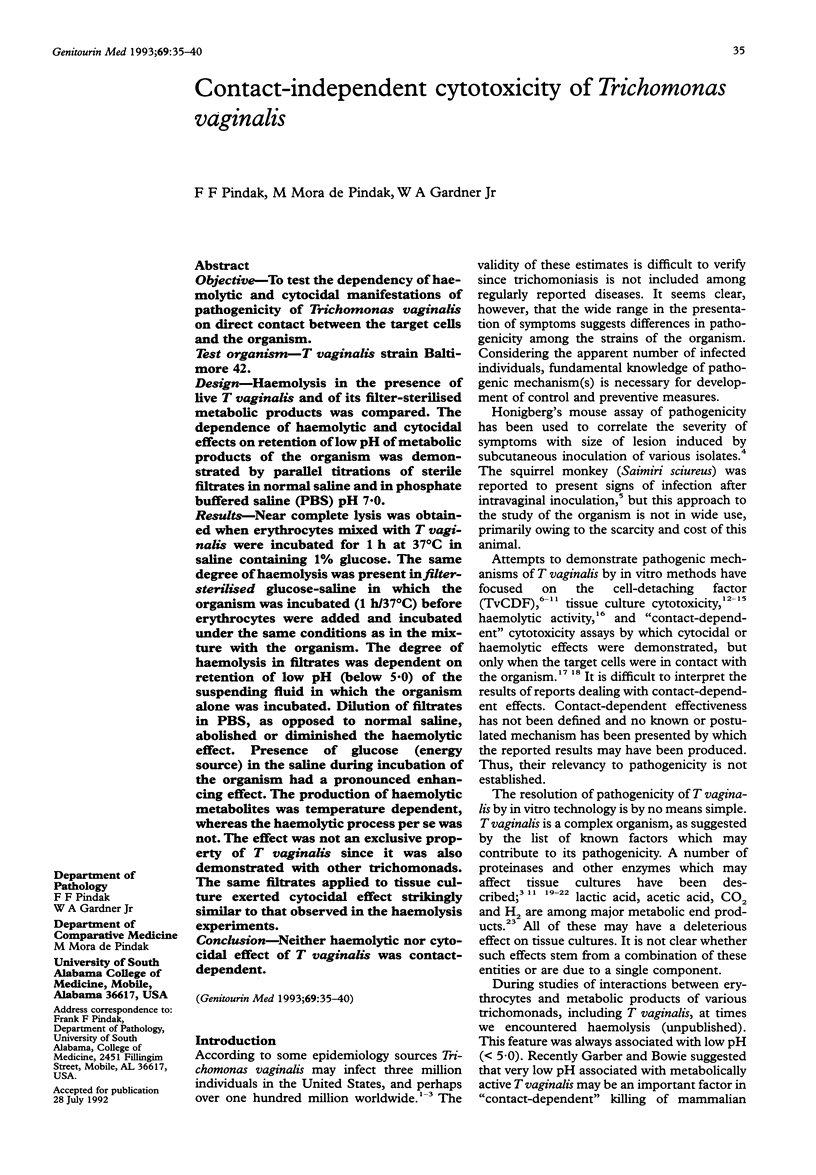
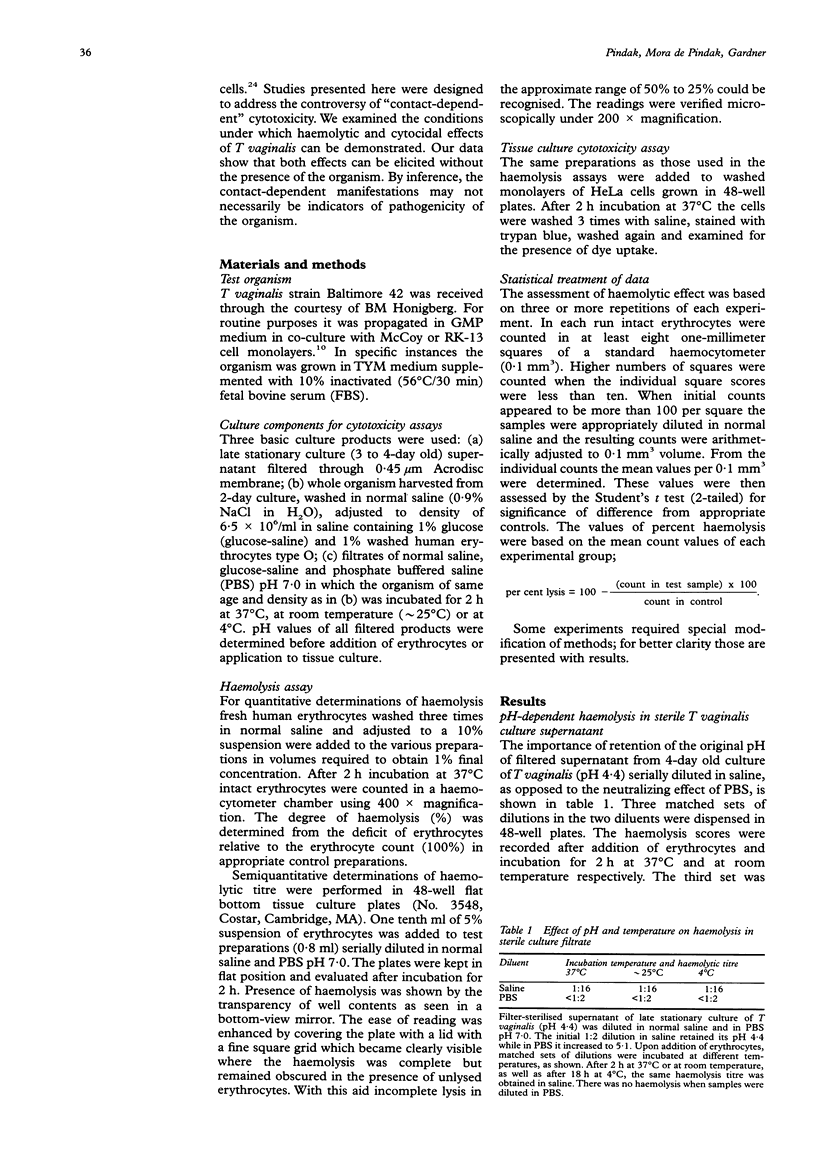
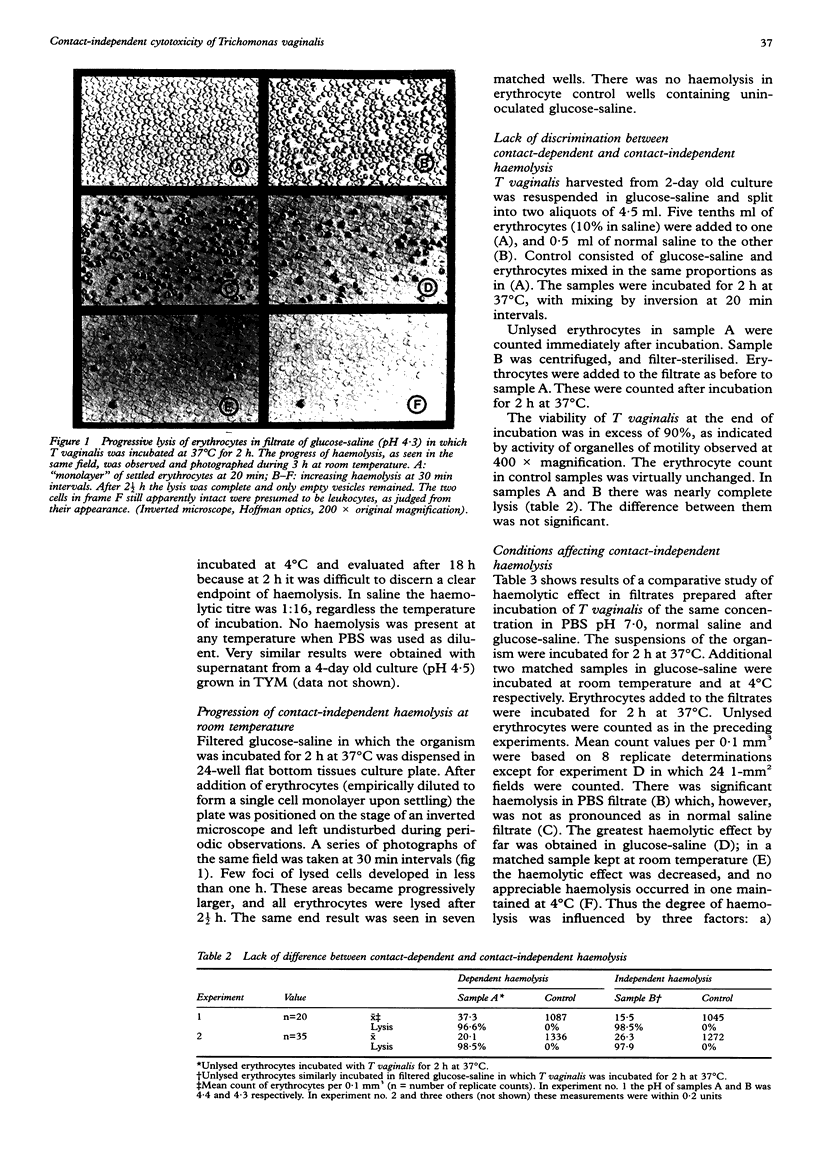

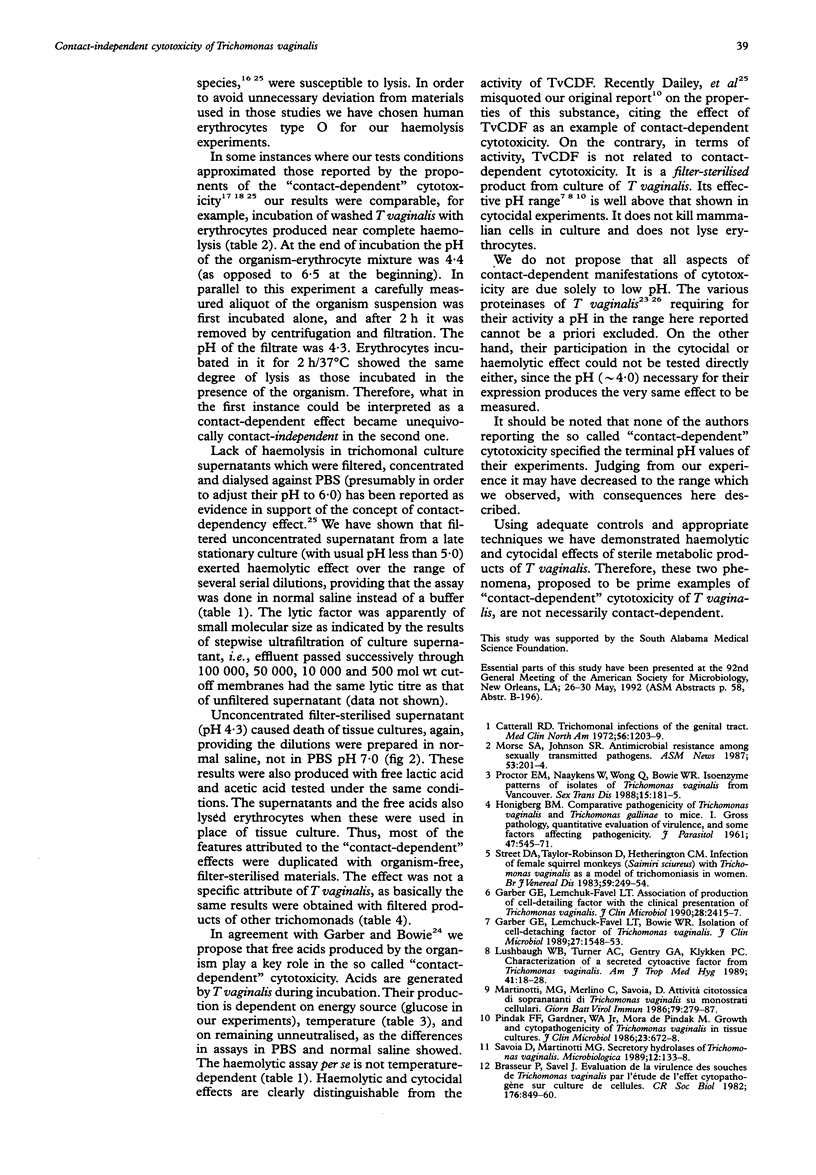
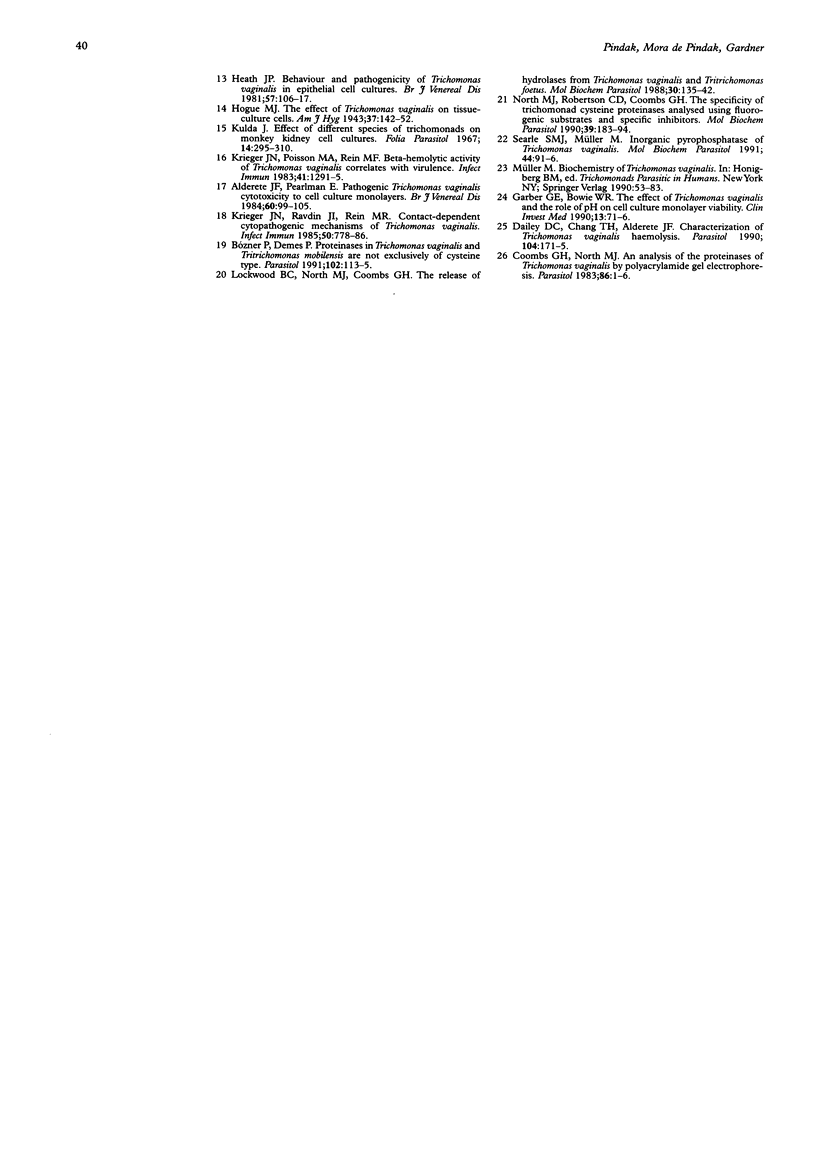
Images in this article
Selected References
These references are in PubMed. This may not be the complete list of references from this article.
- Alderete J. F., Pearlman E. Pathogenic Trichomonas vaginalis cytotoxicity to cell culture monolayers. Br J Vener Dis. 1984 Apr;60(2):99–105. doi: 10.1136/sti.60.2.99. [DOI] [PMC free article] [PubMed] [Google Scholar]
- Brasseur P., Savel J. Evaluation de la virulence des souches de Trichomonas vaginalis par l'étude de l'effet cytopathogène sur culture de cellules. C R Seances Soc Biol Fil. 1982;176(6):849–860. [PubMed] [Google Scholar]
- Bózner P., Demes P. Proteinases in Trichomonas vaginalis and Tritrichomonas mobilensis are not exclusively of cysteine type. Parasitology. 1991 Feb;102(Pt 1):113–115. doi: 10.1017/s0031182000060418. [DOI] [PubMed] [Google Scholar]
- Catterall R. D. Trichomonal infections of the genital tract. Med Clin North Am. 1972 Sep;56(5):1203–1209. doi: 10.1016/s0025-7125(16)32345-8. [DOI] [PubMed] [Google Scholar]
- Coombs G. H., North M. J. An analysis of the proteinases of Trichomonas vaginalis by polyacrylamide gel electrophoresis. Parasitology. 1983 Feb;86(Pt 1):1–6. doi: 10.1017/s0031182000057103. [DOI] [PubMed] [Google Scholar]
- Dailey D. C., Chang T. H., Alderete J. F. Characterization of Trichomonas vaginalis haemolysis. Parasitology. 1990 Oct;101(Pt 2):171–175. doi: 10.1017/s0031182000063204. [DOI] [PubMed] [Google Scholar]
- Garber G. E., Bowie W. R. The effect of Trichomonas vaginalis and the role of pH on cell culture monolayer viability. Clin Invest Med. 1990 Apr;13(2):71–76. [PubMed] [Google Scholar]
- Garber G. E., Lemchuk-Favel L. T. Association of production of cell-detaching factor with the clinical presentation of Trichomonas vaginalis. J Clin Microbiol. 1990 Nov;28(11):2415–2417. doi: 10.1128/jcm.28.11.2415-2417.1990. [DOI] [PMC free article] [PubMed] [Google Scholar]
- Garber G. E., Lemchuk-Favel L. T., Bowie W. R. Isolation of a cell-detaching factor of Trichomonas vaginalis. J Clin Microbiol. 1989 Jul;27(7):1548–1553. doi: 10.1128/jcm.27.7.1548-1553.1989. [DOI] [PMC free article] [PubMed] [Google Scholar]
- HONIGBERG B. M. Comparative pathogenicity of Trichomonas vaginalis and Trichomonas gallinae to mice. I. Gross pathology, quantitative evaluation of virulence, and some factors affecting pathogenicity. J Parasitol. 1961 Aug;47:545–571. [PubMed] [Google Scholar]
- Krieger J. N., Poisson M. A., Rein M. F. Beta-hemolytic activity of Trichomonas vaginalis correlates with virulence. Infect Immun. 1983 Sep;41(3):1291–1295. doi: 10.1128/iai.41.3.1291-1295.1983. [DOI] [PMC free article] [PubMed] [Google Scholar]
- Krieger J. N., Ravdin J. I., Rein M. F. Contact-dependent cytopathogenic mechanisms of Trichomonas vaginalis. Infect Immun. 1985 Dec;50(3):778–786. doi: 10.1128/iai.50.3.778-786.1985. [DOI] [PMC free article] [PubMed] [Google Scholar]
- Lockwood B. C., North M. J., Coombs G. H. The release of hydrolases from Trichomonas vaginalis and Tritrichomonas foetus. Mol Biochem Parasitol. 1988 Aug;30(2):135–142. doi: 10.1016/0166-6851(88)90106-5. [DOI] [PubMed] [Google Scholar]
- Lushbaugh W. B., Turner A. C., Gentry G. A., Klykken P. C. Characterization of a secreted cytoactive factor from Trichomonas vaginalis. Am J Trop Med Hyg. 1989 Jul;41(1):18–28. [PubMed] [Google Scholar]
- Martinotti M. G., Merlino C., Savoia D. Attività citotossica di sopranatanti di Trichomonas vaginalis su monostrati cellulari. G Batteriol Virol Immunol. 1986 Jul-Dec;79(7-12):279–287. [PubMed] [Google Scholar]
- North M. J., Robertson C. D., Coombs G. H. The specificity of trichomonad cysteine proteinases analysed using fluorogenic substrates and specific inhibitors. Mol Biochem Parasitol. 1990 Mar;39(2):183–193. doi: 10.1016/0166-6851(90)90057-s. [DOI] [PubMed] [Google Scholar]
- Pindak F. F., Gardner W. A., Jr, Mora de Pindak M. Growth and cytopathogenicity of Trichomonas vaginalis in tissue cultures. J Clin Microbiol. 1986 Apr;23(4):672–678. doi: 10.1128/jcm.23.4.672-678.1986. [DOI] [PMC free article] [PubMed] [Google Scholar]
- Proctor E. M., Naaykens W., Wong Q., Bowie W. R. Isoenzyme patterns of isolates of Trichomonas vaginalis from Vancouver. Sex Transm Dis. 1988 Oct-Dec;15(4):181–185. doi: 10.1097/00007435-198810000-00001. [DOI] [PubMed] [Google Scholar]
- Savoia D., Martinotti M. G. Secretory hydrolases of Trichomonas vaginalis. Microbiologica. 1989 Apr;12(2):133–138. [PubMed] [Google Scholar]
- Searle S. M., Müller M. Inorganic pyrophosphatase of Trichomonas vaginalis. Mol Biochem Parasitol. 1991 Jan;44(1):91–96. doi: 10.1016/0166-6851(91)90224-t. [DOI] [PubMed] [Google Scholar]
- Street D. A., Taylor-Robinson D., Hetherington C. M. Infection of female squirrel monkeys (Saimiri sciureus) with trichomonas vaginalis as a model of trichomoniasis in women. Br J Vener Dis. 1983 Aug;59(4):249–254. doi: 10.1136/sti.59.4.249. [DOI] [PMC free article] [PubMed] [Google Scholar]




